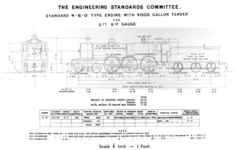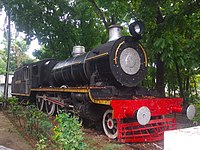| BESA class HP |
|---|
 |
|
| Specifications |
|---|
Configuration:
| |
|---|
| • Whyte | 4-6-0 |
|---|
| • UIC | 2′C n2 |
|---|
| Gauge | 1,676 mm (5 ft 6 in) |
|---|
| Leading dia. | 3 ft 7 in (1,092 mm) |
|---|
| Driver dia. | 74 in (1,880 mm) |
|---|
| Wheelbase: | |
|---|
| • Leading | 7 ft 0 in (2,134 mm) |
|---|
| • Coupled | 6 ft 9 in (2,057 mm) |
|---|
| • incl. tender | Variant with 3000 gallon tender: 50 ft 7 1 ⁄ 2 in (15,430 mm) |
|---|
Length:
| |
|---|
| • Over buffers | Variant with 3000 gallon tender: 60 ft 9 3 ⁄ 4 in (18,535 mm) |
|---|
| Width | 9 ft 6 in (2,896 mm) |
|---|
| Height | 13 ft 6 in (4,115 mm) |
|---|
| Axle load | 16.8 long tons (17.1 t) |
|---|
| Service weight | with 3000 gallon tender: 107 t
with 4000 gallon tender: 113 t
with 4500 gallon tender: 126 t |
|---|
| Water cap. | 3,000 or 4,000 or 4,500 imperial gallons (14,000 or 18,000 or 20,000 L; 3,600 or 4,800 or 5,400 US gal) |
|---|
| Firebox: | |
|---|
| • Type | Belpaire |
|---|
| • Grate area | 32 sq ft (3.0 m2) |
|---|
| Boiler pressure | 180 psi (12.4 bar; 12.7 kgf/cm2) |
|---|
| Heating surface: | |
|---|
| • Tubes | 1,880 sq ft (175 m2) |
|---|
| • Total surface | 2,037 sq ft (189.2 m2) |
|---|
| Cylinders | Two, outside |
|---|
| Cylinder size | 20 in × 26 in (508 mm × 660 mm) |
|---|
| Valve gear | Walschaerts |
|---|
| Valve type | Slide (HP class)
Piston (HPS/HPC class) |
|---|
|
| Performance figures |
|---|
| Tractive effort | Starting: - 11.2 bar boiler pressure: 101 kN (23,000 lbf)
- 9.3 bar boiler pressure: 84 kN (19,000 lbf)
|
|---|
|
| Career |
|---|
| Operators | |
|---|
| Locale | British Raj (until 1947)
India (from 1947)
Pakistan (from 1947)
Bangladesh (from 1971) |
|---|
| Retired | 1980s-early 1990s |
|---|
| Preserved | 2 (India)
1 (Bangladesh) |
|---|
| Disposition | Three preserved, remainder scrapped |
|---|
|
The Class HP (Heavy Passenger) was a 4-6-0 broad gauge passenger steam locomotive introduced in 1906 on the railways of British India. It was one of the BESA locomotives developed by the British Engineering Standards Committee, later called the British Engineering Standards Association (BESA).
History
The HP class passenger locomotive was first catalogued in the BESA report on standard locomotive classes for the British Raj of 1907.[1] Like the AP class, the HP was provided with three different tenders: a small one holding 3000 gallons of water, a medium tender holding 4000, and a large tender holding 4500.
The HP class locomotives were delivered to various railways, but only the Indian States Railways (ISR)-operated railways referred to them as the HP class. They were built by several British locomotive manufacturers, including the Vulcan Foundry, Robert Stephenson and Company, North British Locomotive Company, Kitson and Company and William Beardmore and Company.[2]
A later, superheated version was fitted with a Schmidt superheater and classified as HPS (the S means superheated). Retrofitted HPs with superheaters were classified as HPC (the C means converted).
-
Variant with 3000 gallon tender
-
Variant with 4000 gallon tender
-
Variant with 4500 gallon tender
Design
The locomotives were designed with two cylinders, a Belpaire firebox, and used saturated steam. The grate was arranged between the two rear coupled wheelsets, which had their wheel base lengths increased to accomodate the grate. The cylinders were fitted on the outside and the motion was driven from the second driving wheel. The saturated HPs were fitted with Walschaerts valve gear with slide valves; piston valves were used in the HPS and HPC classes. The running board was positioned low, so splashers had to be fitted above the driving wheels. As with the AP class locomotives, the cab running board is positioned to match the height of the tender running board, and the cab running board also arcs up to the locomotive running board. A small pilot was attached to the front buffer beam. The driver's cab was completely enclosed, with the rear wall of the driver's cab being formed by the tender. The tender was equipped with running boards and handrails along the side walls, which made it possible to reach the train from the locomotive while running.[3]
Preservation
Three HPS class locomotives have been preserved:
| Working | Class | Number | Location | Built | Zone | Builders | Build No | Name |
| No | HPS | 30 | Rajshahi Railway HQ | | | | | |
| No | HPS | 32 | Regional Rail Museum Howrah | | ER | | | |
| No | HPS | 24467 | National Rail Museum | 1950 | RB | Vulcan Foundry Ltd, Newton Le Willows | | |
References
- ^ Second report of the Locomotive committee on standard locomotives for Indian railways. February 1907. pp. 4–5. Retrieved August 31, 2024.
- ^ Llanso, Steve. "Great Indian Peninsula 4-6-0 Locomotives in India". SteamLocomotive.com. Sweat House Media. Retrieved August 31, 2020.
- ^ J. Stuart (1907). "North British Locomotive Company Glasgow (NBL) L294, Indian State Railway (ISR)-East Bengal Railway 234" (in German). Zurich: ETH Library. Retrieved August 31, 2020.
- ^ Schneider, Torsten. "Preserved Steam Locomotives in Bangladesh". International Steam Pages. Retrieved August 28, 2017.
External links
Wikimedia Commons has media related to Indian locomotive class HP.

 Variant with 3000 gallon tender
Variant with 3000 gallon tender Variant with 4000 gallon tender
Variant with 4000 gallon tender Variant with 4500 gallon tender
Variant with 4500 gallon tender Preserved Bangladesh Railway HPS
Preserved Bangladesh Railway HPS Preserved HPS in the National Rail Museum of India
Preserved HPS in the National Rail Museum of India



















